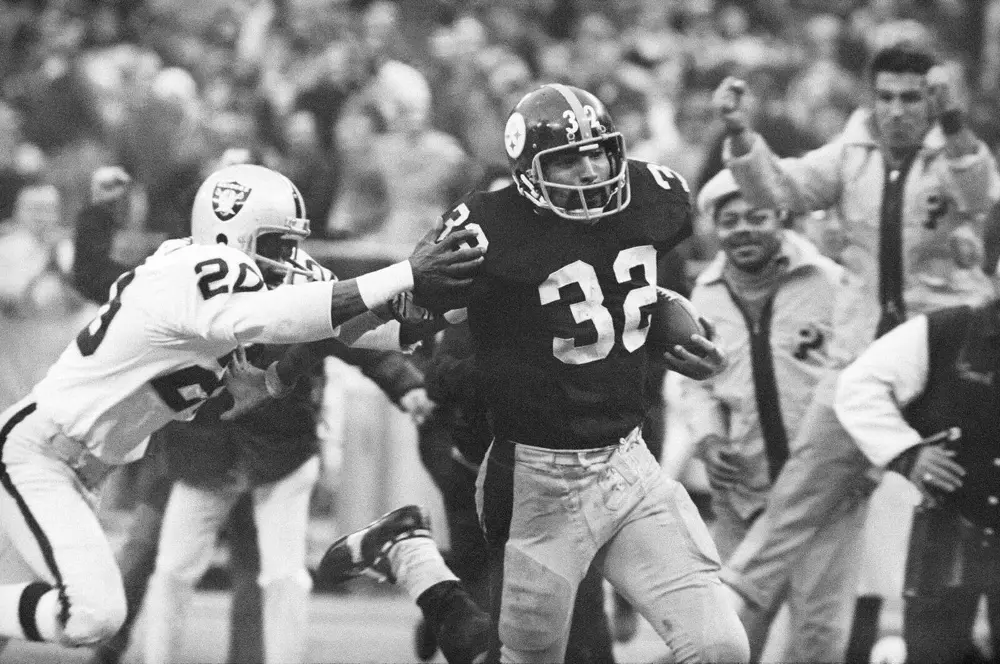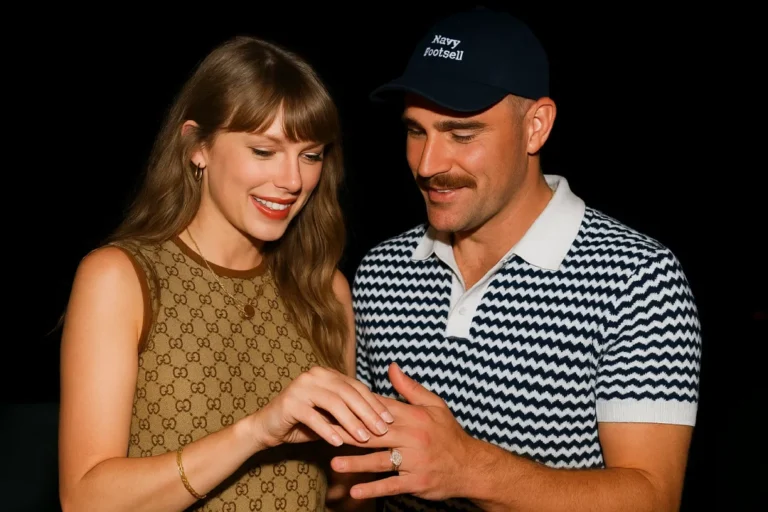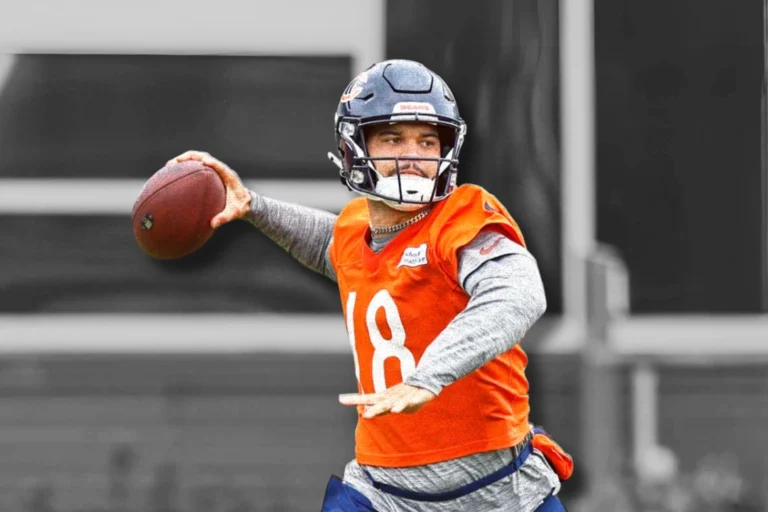Pittsburgh Steelers rookie Franco Harris (#32) stiff-arms Oakland Raiders defender Jimmy Warren as he runs for the game-winning touchdown on the final play known as the “Immaculate Reception,” Dec. 23, 1972.
Setting the Stage: Steelers vs. Raiders in 1972
In 1972, the Pittsburgh Steelers were a franchise with little playoff success. Before that season, the Steelers had never won a playoff game since their founding in 1933.
They were often called lovable losers. But 1972 marked a turning point – the Steelers finished 11–3 and made the postseason for the first time in 25 years. Their opponents in the AFC Divisional playoff were the Oakland Raiders, a battle-tested team led by the brash coach John Madden.
The Raiders had a history of playoff appearances and a reputation as a physical, hard-hitting squad. This matchup on December 23, 1972 at Pittsburgh’s Three Rivers Stadium set the stage for a legendary moment in NFL history.
The Play Unfolds: Franco Harris’ Miraculous Catch
The game was a defensive slugfest, and late in the fourth quarter Pittsburgh trailed 7–6 after Raiders quarterback Ken Stabler scrambled for a go-ahead touchdown. With only 22 seconds left and the Steelers facing 4th-and-10 from their own 40-yard line, desperation set in.
Quarterback Terry Bradshaw took the snap on what would likely be the Steelers’ final play. As the pocket collapsed, Bradshaw rolled right, dodging rushers, and he heaved a pass toward running back John “Frenchy” Fuqua. Fuqua and Raiders safety Jack Tatum collided at the Oakland 35-yard line just as the ball arrived. The impact sent the ball ricocheting backwards in a blur.
No one was sure in that instant who it had bounced off of, or where it was. But Steelers rookie Franco Harris, who had been blocking on the play, alertly kept running toward the ball – a lesson instilled in him by his coaches. Harris scooped the ball inches before it would hit the turf and never broke stride. Clutching it tight, he galloped down the left sideline, stiff-armed the last defender, and dashed into the end zone for a stunning 60-yard touchdown.
The stadium erupted in bedlam as fans poured onto the field in jubilation. In a matter of seconds, the Steelers had snatched victory from defeat on a play that defied belief.
Controversy on the Field: Debating the Immaculate Reception
The miraculous touchdown didn’t immediately end the game – chaos and controversy ensued.
In 1972, NFL rules stated that if an offensive player deflected a pass, another offensive teammate could not legally catch it unless a defender touched it in between. This rule put the Immaculate Reception under instant scrutiny.
Observers were unsure whether the ball had bounced off Fuqua (the Steelers receiver) or Tatum (the Raiders defender) during their collision. If Tatum touched it, the catch by Harris was legal; if only Fuqua touched it, the play by rule should have been ruled dead. To make matters worse, some Raiders players insisted they saw the ball hit the ground as Harris grabbed it.
In the frenzied moments after Harris crossed the goal line, officials on the field were divided and uncertain. Only the back judge had signaled touchdown initially. The referees huddled as thousands of fans swarmed the turf, and minutes of confusion passed with no official ruling. Referee Fred Swearingen even went to the sideline and used a telephone to consult with the NFL’s head of officiating, Art McNally, who was in the press box observing the game. After reportedly hearing that at least two officials believed Tatum had touched the ball (and none were certain it hadn’t touched a defender), McNally gave the go-ahead to confirm the call.
Nearly 10 minutes after the play, Swearingen finally emerged and signaled touchdown, setting off another wave of delirious celebration in the stands. The Oakland sideline was livid – coach John Madden stormed the field to argue, only to be told the decision was made and to get off the field. “We were getting screwed!” Raiders linebacker Phil Villapiano would later joke every year in frustration. Oakland players claimed multiple infractions – illegal touching, the ball hitting the ground, even a missed clipping penalty during Harris’ runback.
Madden’s gripe was less about the rule and more about the process: “If you knew it was a touchdown, then call it a touchdown. If you didn’t know, then how the hell did you find out?” he quipped later, questioning the long delay and consultation.
To this day, slow-motion replays remain inconclusive as to whether the ball grazed the ground or who it hit first – adding to the enduring mystique of the Immaculate Reception.
Aftermath: Pandemonium and a New Rivalry Begins
Once the touchdown was upheld, the final score was Steelers 13, Raiders 7, and Pittsburgh had won its first playoff game ever. The result was a shock for Oakland and a euphoric moment for Pittsburgh.
Steelers owner Art Rooney, who had already headed to the locker room in defeat before Harris made the catch, famously rode the elevator down as a “loser” and emerged at field level as a winner, astonished by the turnaround.
In the locker room, Frenchy Fuqua – whose involvement in the deflection was at the heart of the controversy – coyly told Rooney, “Should I tell them what happened?” The cigar-chomping Rooney grinned and replied, “Frenchy, keep it to yourself,” and Fuqua thereafter refused to ever reveal whether the ball had touched him or not. The Raiders, meanwhile, stewed over the loss and felt robbed by the officiating.
Madden told his team simply, “We got [expletive]… we’ll never get to the bottom of it,” accepting that the truth of that play might never be fully known. This dramatic clash became the spark of a heated rivalry between the Steelers and Raiders through the 1970s. The two teams would face off in multiple playoff rematches in the coming years, fueling a bitter competition.
The Immaculate Reception also had an immediate impact on the Steelers’ trajectory – it catapulted Pittsburgh toward a dynasty. Though the Steelers lost the next week’s AFC Championship, the young team gained enormous confidence.
Within two seasons, they were Super Bowl champions, and by the end of the 1970s Pittsburgh had claimed four Super Bowl titles. Many point to Franco Harris’ miraculous catch as the franchise’s watershed moment that kicked off an era of dominance.
As Steelers linebacker Andy Russell said, “It was the birth of the Steelers. That one play gave us the belief we could beat anybody.” The play’s legacy was just beginning.
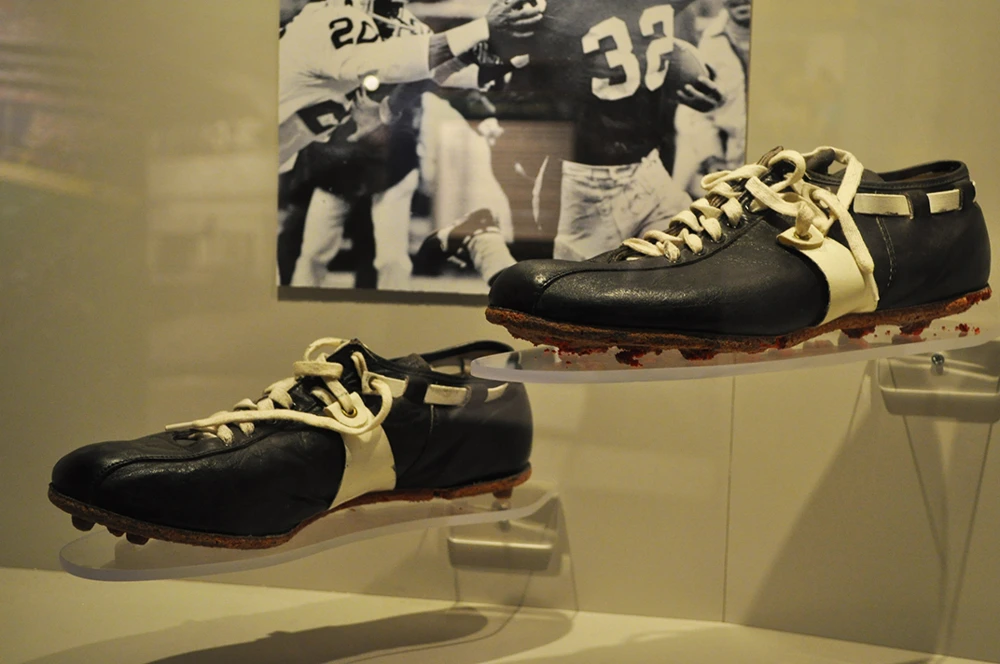
The actual shoes Franco Harris wore during the Immaculate Reception are preserved on display at the Heinz History Center in Pittsburgh. In the background, a photo of Harris’ shoestring catch is visible.
“Immaculate Reception” – A Story Becomes Legend
What truly cemented this play’s place in lore was its famous name: “The Immaculate Reception.” The morning after the game, Pittsburgh sportscaster Myron Cope was searching for a catchy description for the miraculous catch.
He received a call from a local fan, Sharon Levosky, who said her boyfriend Michael Ord coined the phrase “Immaculate Reception” while celebrating at a bar after the game. The name – a playful riff on the religious concept of the Immaculate Conception – perfectly captured the sense of divine providence that Steelers fans felt about the play.
Cope loved it, mentioned “Immaculate Reception” on his broadcast, and the term instantly caught on. Ever since, this bit of wordplay has become as iconic as the play itself. The lore only grew over time. The catch was immediately hailed as one of football’s greatest moments, and as years passed it topped virtually every list of memorable NFL plays.
NFL Films later voted the Immaculate Reception the greatest play in NFL history, and decades of polls and documentaries have upheld its legendary status. In Pittsburgh, the Immaculate Reception turned Franco Harris into a folk hero. Harris was named the game’s MVP and became the centerpiece of the Steelers’ future success.
Raiders fans, of course, felt the play was more infamy than miracle – but even they acknowledge its place in history. The term “Immaculate Reception” has entered the American sports lexicon, invoked anytime a wild, last-second catch occurs.
Legacy and Commemoration 50 Years Later
Five decades on, the Immaculate Reception still looms large in NFL culture. Every December 23 in Pittsburgh, fans reminisce about that chilly day in 1972 when their fortunes changed.
Franco Harris himself celebrated the anniversary annually – even playfully phoning Raiders rival Phil Villapiano each year to ask, “Hey Phil, what were you doing around this time back in ’72?” only to enjoy the good-natured groan that followed.
In 2012, on the 40th anniversary, the city of Pittsburgh unveiled a historical marker at the exact spot where Harris made the catch. Harris stood on that very spot, thumbs-up and proud, as the bronze plaque commemorating the “Immaculate Reception” was revealed.
Franco Harris in 2012 at the unveiling of a historical marker on Pittsburgh’s North Side, near the site of Three Rivers Stadium, celebrating the 40th anniversary of the Immaculate Reception.
At the Pittsburgh International Airport, a life-size statue of Franco Harris in the act of making the Immaculate Reception greets travelers – a testament to how ingrained the moment is in local lore.
The very football from the play was famously scooped up by a fan in the stands after the game-winning touchdown (when the ball fell to the turf during the post-touchdown chaos). That fan, Jim Baker, still keeps the ball secured in a safe to this day as a cherished memento of the game.
In the Western Pennsylvania Sports Museum, exhibits feature the chunk of Three Rivers Stadium turf where the miracle catch took place (cut out and saved when the stadium was demolished) and even Franco’s mud-stained cleats from that day.
The legacy extends beyond Pittsburgh. The NFL as a whole recognizes the Immaculate Reception as a defining moment. In 2022, on the play’s 50th anniversary, the Steelers were set to retire Franco Harris’ jersey #32 in a prime-time ceremony – an honor occurring 50 years and one day after the catch.
Poignantly, Franco Harris passed away just two days before that 50th anniversary celebration, at age 72. His death brought an outpouring of tributes, and fans gathered at his airport statue and around the city to mourn and celebrate his life. The anniversary game went on, with Harris’ memory deeply felt, and the Steelers paid tribute by winning in dramatic fashion, almost as if scripted.
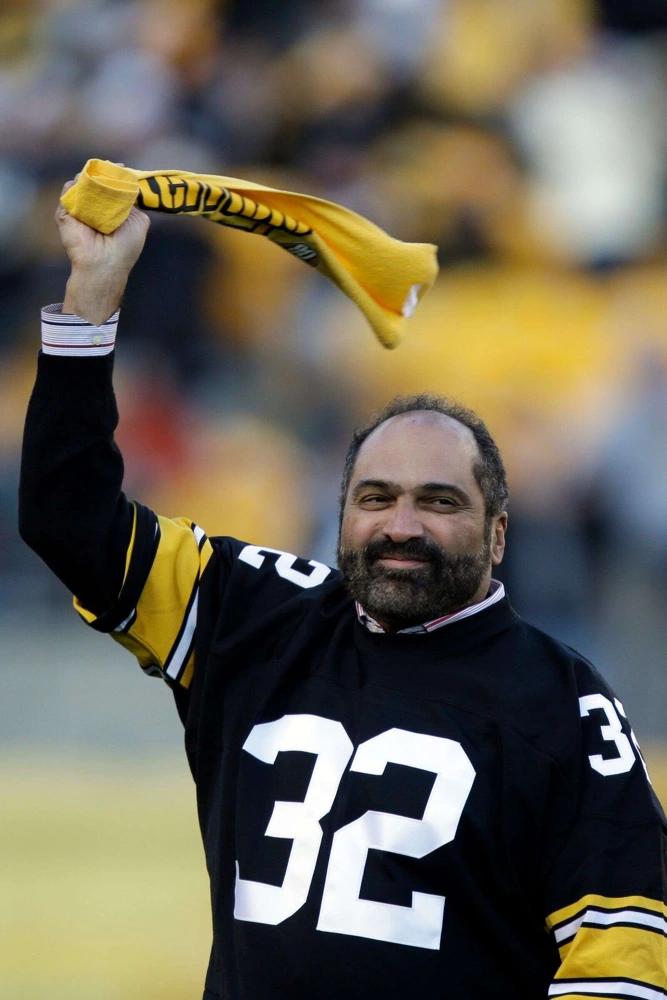
Steelers legend Franco Harris twirls the “Terrible Towel” and salutes fans during a ceremony commemorating the Immaculate Reception’s 40th anniversary in 2012. Harris remained an icon in Pittsburgh, celebrated for the play that sparked a dynasty.
To this day, the Immaculate Reception symbolizes hope, resilience, and a little bit of luck – the idea that no game is ever over until the final whistle.
It turned the tide for a long-suffering franchise and gave rise to a football dynasty. It spawned endless debates at barbershops and sports bars over whether “the ball touched the ground” or “hit Fuqua or Tatum,” making it also the NFL’s most enduring what-if moment. But for Steelers fans, there is no debate about the result: it was the birth of a champion team.
The Immaculate Reception lives on in statues, museum displays, highlight reels, and the hearts of Pittsburghers who will proudly tell you that they remember exactly where they were when Franco “caught that sucker right out of the air.” It’s more than just a play – it’s an event that has taken on a life of its own in football folklore, truly immaculate in every sense of the word.

